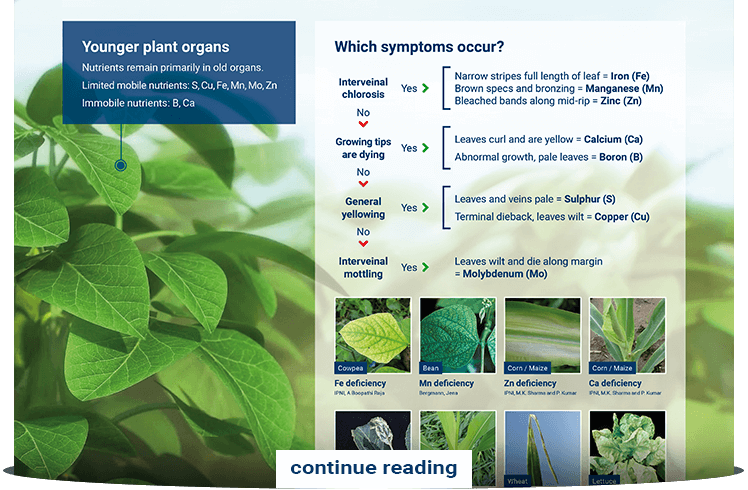Nutrient Functions and Deficiencies
Your plants need the right nourishment to ensure the best crops. That means getting to know the nutrients and understanding their functions and deficiencies. Certain nutrients in the plant cause growth and reproduction. Macronutrients are consumed in relatively large amounts and micronutrients are consumed in smaller amounts. All nutrients are necessary for proper plant growth but if one nutrient is lacking, whether at the macro or micronutrient level, your plant growth will be impaired.
High quality, perfectly balanced WUXAL® foliar fertilizers provide your crops with all the nutrients they need. Fast nutrient uptake and rapid corrections to nutrient deficiencies are possible due to tailor-made nutrient solutions. Learn more about the different nutrient functions and deficiencies below.
Identify your nutrient deficiency
- Quick evaluation of the situation in the field
- Easy identification of a nutrient deficiency step by step
- Covering of all essential plant nutrients

-
 Nitrogen
NitrogenFunctions
- component of amino acids, nucleic acids, proteins, enzymes, chlorophyll and phytohormones
- stimulates vegetative growth
Deficiency symptoms
- pale green chlorosis due to chlorophyll decomposition
- low tillering rate and reduced growth
-
 Phosphorus
PhosphorusFunctions
- regulates energy metabolism
- important constituent of cell membranes and nucleic acids
- promotes root growth and accelerates ripening
- improves firmness, red surface color and storability of fruits
Deficiency symptoms
- stunted and dark green plants
- purpling of stem, petiole and underside of the leaves
-
 Potassium
PotassiumFunctions
- improves osmotic pressure of cells
- regulates water retention
- enhances resistance to frost and drought
- promotes sugar production and storability
Deficiency symptoms
- scorching and/or necrosis progressing from the leaf margin to the midrib
- slow growth and poor root system development
- crops are less resistant to moisture stress and diseases
-
 Calcium
CalciumFunctions
- responsible for structural and physiological stability of plant tissue
- promotes cell division (fruit size) and cell wall formation
- prevents physiological disorders to fruit and prolongs shelf life
Deficiency symptoms
- necrosis around the base of the leaves and death of the growing regions of roots and leaves
- blossom-end rot of tomato, tip burn of lettuce, blackheart of celery, bitter pit of apple
-
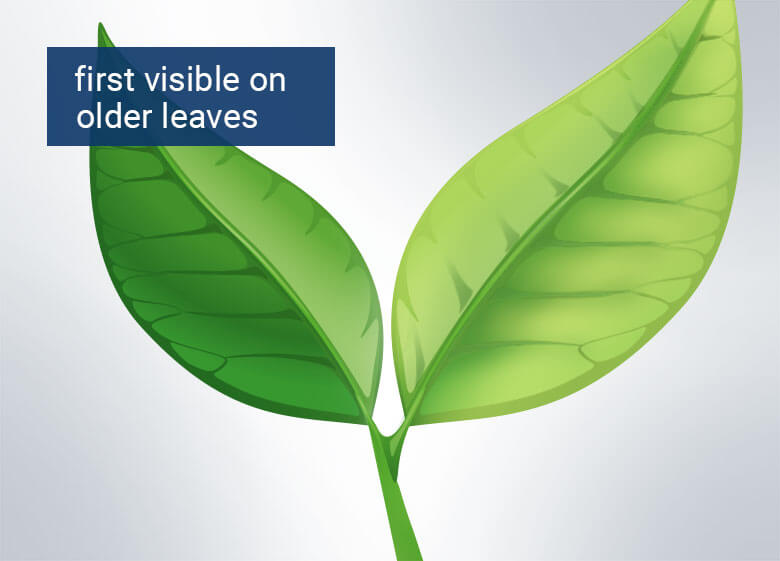 Magnesium
MagnesiumFunctions
- structural part of the chlorophyll molecule
stimulates photosynthesis - activates more enzyme systems than any other nutrient
Deficiency symptoms
- interveinal chlorosis that can turn into necrosis
- raised, puckered surface
- structural part of the chlorophyll molecule
-
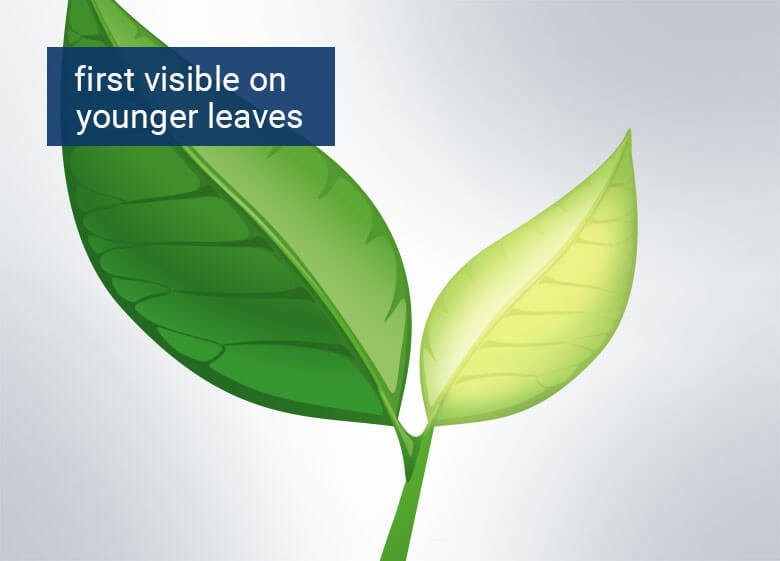 Sulphur
SulphurFunctions
- constituent of some amino acids and, hence, of proteins
- ingredients of secondary metabolites like glycosylates
- responsible for the unique taste of many food plants
Deficiency symptoms
- overall yellow chlorosis retaining some green color, much more uniform over the entire plant compared to nitrogen
- reddish veins and petioles with brown lesions and/or necrotic spots
-
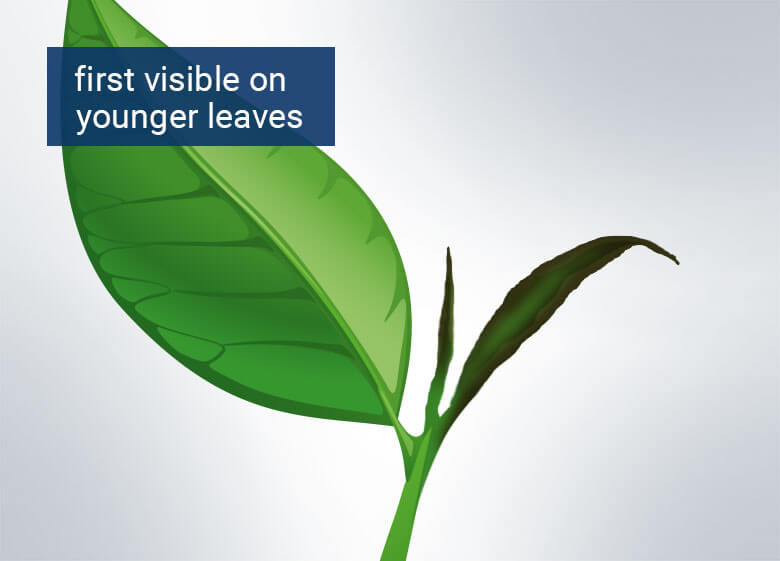 Boron
BoronFunctions
- important for cell wall stabilization
- improves sugar production and transportation
- promotes pollen fertility and fruit set
- necessary for auxin metabolism
Deficiency symptoms
- light chlorosis of leaves
- abnormal growth, eventually necrosis, on the youngest leaves and meristematic tissue
- heart rot in sugar beet
-
 Copper
CopperFunctions
- involved in sugar and protein production
- important for photosynthesis
- improves plant resistance to disease
Deficiency symptoms
- light, overall chlorosis
- reduced, stunted or distorted young growth
-
 Iron
IronFunctions
- important for chlorophyll formation
- promotes photosynthesis and protein metabolism
- involved in the respiration chain
Deficiency symptoms
- strong chlorosis at the leaf base
- starts as an interveinal chlorosis and ends as a totally bleached leaf
-
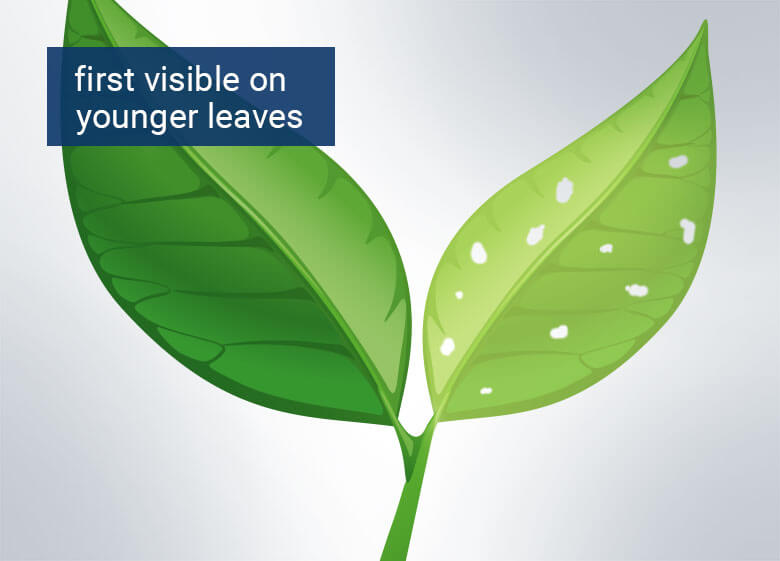 Manganese
ManganeseFunctions
- extremely important for photosynthesis and N-metabolism
- improves green ground color of fruit
- enhances resistance to fungal diseases
Deficiency symptoms
- light interveinal chlorotic dots with stunted growth
- necrotic areas on the leaves
-
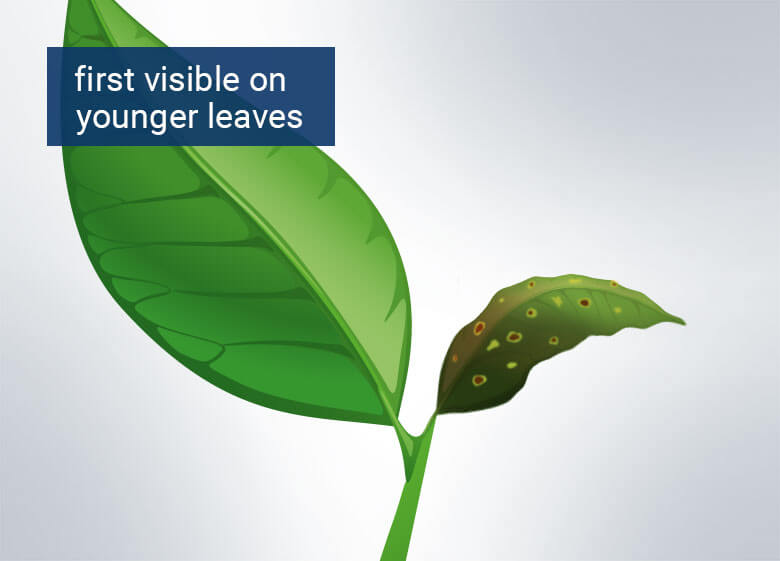 Molybdenum
MolybdenumFunctions
- essential for activation of nitrate reductase
- key to nitrogen fixation in legumes
Deficiency symptoms
- mottled spotting along with some interveinal chlorosis
- whiptail appearance
-
 Zinc
ZincFunctions
- stimulates a series of important enzymes
- important for CO2-fixation and plant growth regulator synthesis
Deficiency symptoms
- chlorosis in the interveinal areas of young leaves
- stunted growth in leaf and plant growth
The myWUXAL App
Whether your goal is beautiful fruit coloration or high sugar formation or both, you need to have an eye on your plant nutrition. As nutrient mobility is often limited within the plant and nutrient supply via the soil is insufficient, targeted foliar fertilizer applications are the best way to ensure your crops show the desired results. Learn more about what properties you can promote in your crops with myWUXAL.
